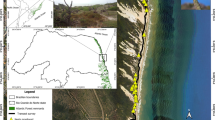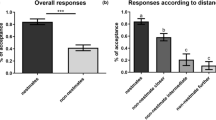Abstract
We examined aggregative behavior of hatchlings of the desert locust Schistocerca gregaria emerging from solitaria egg pods that had been incubated in sand previously used for consecutive ovipositions by gregarious females. Hatchlings derived from such eggs were significantly more gregarious than those derived from pods laid in clean sand. The gregarizing effect of the sand-associated factor originating from 3, 5, or 10 ovipositions by gregarious females increased in a dose-dependent fashion. Washing the sand with organic solvents following such ovipositions, or flushing it with nitrogen gas, led to substantial loss of its gregarizing effect, showing that the active signal is volatile and of medium polarity. The gregarizing activity of the exposed sand correlated with the presence of C-8 unsaturated ketones, (Z)-6-octen-3-one and (E,E)-3,5-octadiene-2-one and its E,Z isomer, previously shown by us to form part of the releaser pheromone system that mediates group oviposition in S. gregaria. These ketones were present in relatively large amounts in the eggs obtained from egg pods of gregarious females and were also detected in the extracts of accessory glands of gregarious females, a candidate source of the gregarization factor. It is proposed that the pheromone is secreted at the onset of oviposition. This would account for its distribution predominantly within the eggs and surrounding sand at the site of oviposition. The study sheds new light on the pheromonal mechanism associated with transgenerational transmission of gregarious characters in crowded S. gregaria populations and provides yet another case in this insect of dual releaser and primer roles played by the same pheromone blend.
Similar content being viewed by others
REFERENCES
APPLEBAUM, S. W., AVISAR, E., and HEIFITZ, Y. 1997. Juvenile hormone and locust phase. Arch. Insect Biochem. Physiol. 35:395-391.
ASSAD, Y. O. H., HASSANALI, A., TORTO, B., MAHAMAT, H., BASHIR, N. H. H., and EL BASHIR, S. 1997. Effects of fifth instar volatiles on the sexual maturation of adult desert locust Schistocerca gregaria (Forskal) (Orthoptera:Acrididae). J. Chem. Ecol. 23:1373-1388.
BASHIR, M. O., HASSANALI, A., RAI, M. M., and SAINI, R. K. 2000. Changing oviposition preferences of the desert locust, Schistocerca gregaria, suggest a strong species predisposition for gregarization. J. Chem. Ecol. 26:1721-1733.
BOUAÏCHI, A., ROESSINGH, P., and SIMPSON, S. J. 1995. Analysis of the behavioral effects of crowding and re-isolation on solitary-reared adult desert locusts (Schistocerca gregaria) and their offspring. Physical Entomol. 20:199-208.
DENG, A. L., TORTO, B., HASSANALI, A., and ALI, E. E. 1996. Effects of shifting to crowded or solitary conditions on pheromone release and morphometrics of the desert locust, Schistocerca gregaria (Forskål) (Orthoptera:Acrididae). J. Insect Physiol. 42:771-776.
ELLIS, P. E. 1953. Social aggregation and gregarious behavior in hoppers of Locusta migratoria migratorioides (R & F). Behavior 5:17-258.
ELLIS, P. E. 1963. Changes in the social aggregation of locust hoppers with changes in rearing conditions. Anim. Behav. 11:152-160.
HäGELE, B. F., OAG, V., BOUAÏCHI, A., MCCAFFERY, A. R., and SIMPSON, S. J. 2000. The role of female accessory glands in maternal inheritance of phase in the desert locust Schistocerca gregaria. J. Insect Physiol. 46:275-280.
HASSANALI A., and TORTO B. 1999. Grasshoppers and locusts, pp. 305-328, in J. HARDIE, and A. K. Minks (eds.). Pheromones of Non-lepidopteran Insects Associated with Agricultural Plants. CABI Publishing, Wallingford, Oxon, UK.
ISLAM, M. S., ROESSINGH, P., SIMPSON, S. J., and MCCAFFERY, A. R. 1994a. Parental effects on the behavior and colouration of nymphs of the desert locust Schistocerca gregaria. J. Insect Physiol. 40:173-181.
ISLAM, M. S., ROESSINGH, P., SIMPSON, S. J., and MCCAFFERY, A. R. 1994b. Effects of population density experienced by parents during mating and oviposition on the phase of hatching desert locusts, Schistocerca gregaria. Proc. R. Soc. B 257:93-98.
MAHAMAT, H., HASSANALI, A., ODONGO, H., TORTO, B., and EL BASHIR, S. 1993. Studies on the maturation-accelerating pheromone of the desert locust, S. gregaria (Orthoptera:Acrididae). Chemoecology 4:159-164.
MCCAFFERY, A. R., SIMPSON, S. J., SAIFUL, ISLAM, M., and ROESSINGH, P. 1998. A gregarising factor present in the egg pod foam of the desert locust Schistocerca gregaria. J. Exp. Biol. 201:347-363.
NJAGI, P. G. N., TORTO, B., OBENG-OFORI, D., and HASSANALI, A. 1996. Phase-independent responses to phase-specific aggregation pheromone in adult desert locust, Schistocerca gregaria (Forskål) (Orthoptera:Acrididae). Physiol. Entomol. 21:131-137.
NORRIS, M. J. 1968. Laboratory experiments on oviposition responses of the desert locust, Schistocerca gregaria (Forskål). Anti-Locust Bull. 43:1-47.
OCHIENG-ODERO, J. P. R., NDUGO, S. M., EL BASHIR, S., and CAPSTICK, P. B. 1994. A method of rearing crowded (gregarious) and isolated (solitary) locusts (Orthoptera: Acrididae) in the laboratory, pp. 33-44, in P. G. N. Njagi, and M. F. B. Chaudhury (eds.). Proceedings of Workshop on Effective Networking of Research and Development on Environmentally Sustainable Locust Control Methods among Locust Affected Countries. ICIPE Science Press, Nairobi, Kenya.
PENER, M. P. 1991. Locust phase polymorphism and its endocrine relations. Adv. Insect Physiol. 23:1-79.
PENER, M. P., and YERUSHALMI, Y. 1998. The physiology of locust phase polymorphism: An update. J. Insect Physiol. 44:365-377.
RAI, M. M., HASSANALI, A., SAINI, R. K. ODONGO, H., and KAHORO, H. 1997. Identification of components of the oviposition aggregation pheromone of the gregarious desert locust Schistocerca gregaria. J. Insect Physiol. 43:83-97.
RICHARDS, M. J., and EL MANGOURY, M. A. 1968. Further experiments on the effects of social factors on the rate of sexual maturation in the desert locust. Nature 219:865-866.
ROESSINGH, P., and SIMPSON, S. J. 1994. The time-course of behavioral phase change in nymphs of the desert locust, Schistocerca gregaria. Physiol. Entomol. 19:191-197.
ROESSINGH, P., SIMPSON, S. J., and JAMES, S. 1993. Analysis of phase-related changed in the behaviour of desert locust nymphs. Proc. R. Soc. B 252:43-49.
SAINI, R. K., RAI, M. M., HASSANALI, A., WAWIYE, J., and ODONGO, H. 1995. Semiochemicals from froth of egg pods attract ovipositing female Schistocerca gregaria. J. Insect Physiol. 41:711-716.
SOKAL R. R., and ROHLF, F. J. 1981. Biometry, 2nd ed. Freeman, New York.
SZOPA, T. M. 1981. The role of the accessory reproductive glands and genital ducts in egg pod formation in female Schistocerca gregaria. J. Insect Physiol. 27:23-29.
TORTO, B., OBENG-OFORI, D., NJAGI, P. G. N., HASSANALI, A., and AMIANI, H. 1994. Aggregation pheromone system of adult gregarious desert locust, Schistocerca gregaria (Forskål) (Orthoptera:Acrididae). J. Chem. Ecol. 20:1749-1762.
TORTO, B., NJAGI, P. G. N., HASSANALI, A., and AMIANI, H. 1996. Aggregation pheromone system of nymphal gregarious desert locust, Schistocerca gregaria (Forskål) (Orthoptera:Acrididae). J. Chem. Ecol. 22:2273-2281.
TORTO, B., ASSAD, Y. O. H., NJAGI, P. G. N., and HASSANALI, A. 1999. Evidence for additional pheromonal components mediating oviposition aggregation in Schistocerca gregaria. J. Chem. Ecol. 25:835-845.
UVAROV, B. P. 1966. Grasshoppers and Locusts, Vol. 1. Cambridge University Press, London, 481 pp.
WEISEL G., TAPPERMANN S., and DORN A. 1996. Effects of juvenile hormone and juvenile hormone analogues on the phase behaviour of Schistocerca gregaria and Locusta migratoria. J. Insect Physiol. 42:385-395.
Author information
Authors and Affiliations
Rights and permissions
About this article
Cite this article
Malual, A.G., Hassanali, A., Torto, B. et al. The Nature of the Gregarizing Signal Responsible for Maternal Transfer of Phase to the Offspring in the Desert Locust Schistocerca gregaria. J Chem Ecol 27, 1423–1435 (2001). https://doi.org/10.1023/A:1010321410936
Issue Date:
DOI: https://doi.org/10.1023/A:1010321410936




